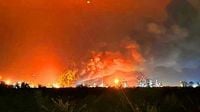Late on the evening of October 20, 2025, the quiet industrial town of Százhalombatta, just 27 kilometers south of Budapest, was rocked by a dramatic fire and explosion at Hungary’s main oil refinery. The Danube Refinery, operated by energy giant MOL, is not just a local landmark—it’s the country’s only major crude-processing facility and a linchpin in Hungary’s energy infrastructure. As flames and thick smoke billowed into the night sky, visible from several kilometers away, residents and authorities alike braced for what could have been a disaster of national proportions.
According to the Associated Press, the fire broke out in the AV3 unit, a crucial raw material processing plant within the refinery. Eyewitnesses described the scene as both terrifying and surreal, with one resident from the nearby town of Érd recounting on social media, “Fifteen minutes ago we woke up to the sound of an explosion at a MOL plant next to us. The sky is red from the flames.” Another passerby noted, “On Monday evening, the smell of oil on the M6 near Százhalombatta was unbearable. Much worse than a petrol station. You could already tell that something was wrong.”
The incident quickly mobilized a massive emergency response. MOL’s own facility firefighters were first on the scene, joined by professional units from surrounding municipalities—including Érd, Törökbálint, Szigetszentmiklós, and Budapest—operating at the highest alert level, as reported by Hungary’s National Directorate General for Disaster Management. In total, seventeen firefighting units, equipped with water cannons and foam, worked through the night. Mobile disaster response laboratories and specialized chemical and powder foam containers were also deployed, ensuring a coordinated and robust attack on the blaze.
By the early hours of October 21, 2025, the fire was contained. No injuries were reported—a fact repeatedly confirmed by MOL and Hungarian authorities. The company’s statement, posted to the Budapest Stock Exchange website and echoed by Reuters, emphasized that “safety protocols were followed, and units not affected by the fire gradually restarted on Tuesday.”
Yet, questions lingered about the cause of the explosion and subsequent fire. MOL’s Downstream Production and Development Senior Vice President, Krisztian Pulay, sought to allay concerns at a news briefing, saying, “We have seen no signs that any external tampering played a role in the outbreak of the fire.” As of October 21, 2025, the exact cause remained under investigation, with MOL pledging to assess the damage within the next 24 hours and to conduct a thorough review of the incident.
Prime Minister Viktor Orbán, never one to shy away from a crisis, took to social media to reassure the nation. He stated, “Hungary’s fuel supply is secure,” and promised that “the circumstances surrounding the blaze are being investigated as thoroughly as possible.” Orbán added, “We will investigate the circumstances of the fire at the Százhalombatta oil refinery with the utmost rigour.” The Prime Minister’s quick communication reflected the gravity of the situation, as the refinery is responsible for processing over 40% of Hungary’s crude oil intake, according to LSEG data cited by Reuters.
The Danube Refinery’s strategic importance cannot be overstated. With a daily capacity of 165,000 barrels of crude oil, the facility primarily processes Russian oil delivered via the Druzhba (Barátság) pipeline. This reliance on Russian crude is unusual within the European Union, where most member states have drastically reduced or eliminated Russian energy imports following Moscow’s invasion of Ukraine in 2022. Hungary, however, has maintained—and even increased—its Russian imports, citing a lack of viable alternatives. As AP News noted, this makes the Százhalombatta refinery a unique and critical node in both Hungary’s and the region’s energy landscape.
Despite the dramatic visuals and the refinery’s central role in Hungary’s energy security, authorities and independent monitoring agencies moved swiftly to allay public health concerns. Air quality around the refinery was monitored continuously throughout the night and into the next day. Officials reported that no readings above established health limits were detected, according to Hungary’s disaster management authority. Still, social media posts from residents complained of strong odors and fumes, a reminder of the tangible impact such industrial accidents can have on local communities.
In the aftermath, MOL announced that it would focus on ensuring domestic fuel supplies and, if necessary, draw on Hungary’s strategic oil reserves. At the end of September 2025, Hungary had enough crude and petroleum product reserves to cover 96 days, according to the Hungarian Hydrocarbon Stockpiling Association. Tamas Pletser, a regional energy analyst at Erste Investment, told Reuters that the fire could disrupt refinery production for months, potentially forcing MOL to increase fuel imports or tap further into strategic reserves. The fire might also affect Hungary’s ability to supply fuel to neighboring Serbia, especially after the U.S. imposed sanctions on Serbia’s Russian-owned NIS refinery earlier in October.
Meanwhile, the local government in Százhalombatta played an active role in the emergency response. Mayor Mihály Vezér wrote on social media that the city’s leadership team had been called into service and remained in close contact with the refinery’s emergency response team. The collaborative approach between municipal authorities and MOL was widely credited for the swift containment of the fire and the prevention of injuries.
For many in Hungary, the incident reignited debates about energy security and the country’s continued dependence on Russian oil. As the European Union presses forward with plans to phase out Russian energy imports by the end of 2027, Hungary’s unique position—and the vulnerabilities it brings—are once again in the spotlight. The refinery’s previous incident in July 2025, when black smoke was seen billowing from the facility, is a stark reminder that industrial accidents are not isolated events but part of a broader conversation about infrastructure, safety, and national resilience.
In a separate but related development, the same day also saw an explosion at the Petrotel-Lukoil oil refinery in Ploiesti, Romania. Unlike the Százhalombatta fire, the Romanian incident did not result in a fire, but a 57-year-old worker suffered serious injuries and was hospitalized in intensive care, as reported by economica.net. The Romanian refinery had been shut down for scheduled maintenance at the time, highlighting the inherent risks associated with oil refining across the region.
Back in Hungary, as the smoke clears over Százhalombatta, the country’s leaders, energy executives, and residents are left to reflect on a near-miss that could have had far more serious consequences. With investigations ongoing and repairs underway, the Danube Refinery stands as both a symbol of Hungary’s industrial strength and a reminder of the delicate balance between energy security and operational risk.
For now, Hungary’s fuel supply remains secure, and life in Százhalombatta slowly returns to normal. But the fire at the Danube Refinery has left an indelible mark—one that will shape conversations about energy, safety, and sovereignty for months, if not years, to come.

